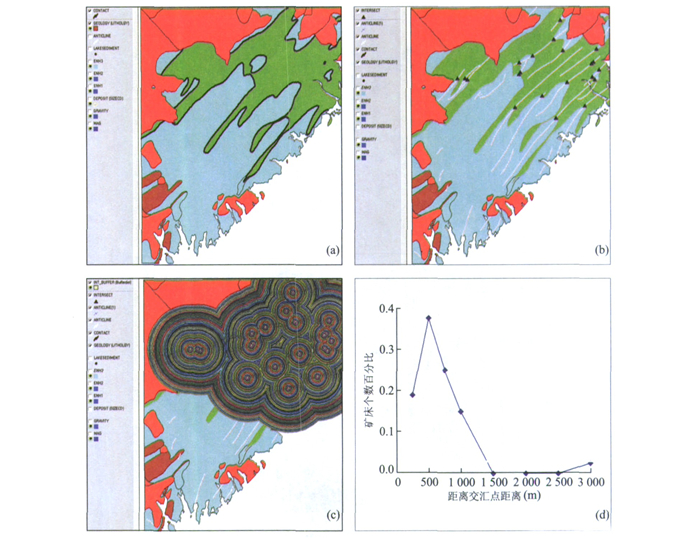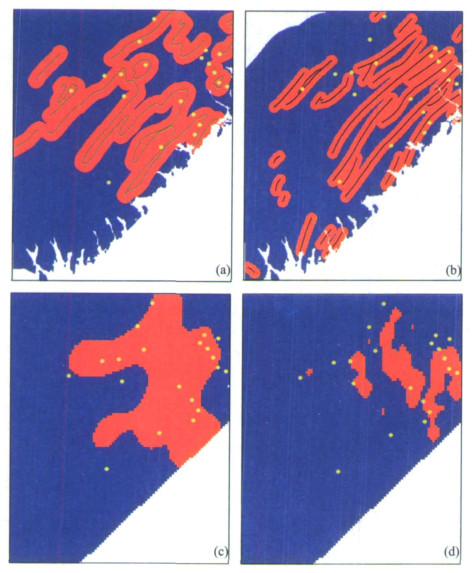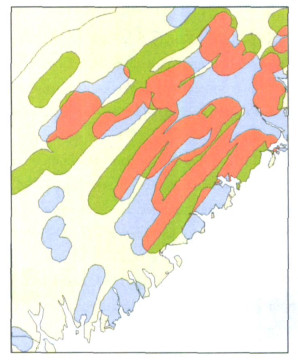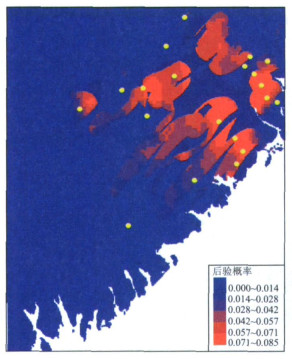Application of GIS-Model Builder Technology for National Mineral Resource Assessment
-
摘要:
在GIS技术环境下开展资源定量评价, 实现资源评价工作的自动化、数字化、智能化是矿产资源勘查与预测的重要发展趋势.为了给地质勘查与预测人员、定量建模人员、GIS分析与操作人员提供共同研究和技术讨论平台, 提出了在矿产资源预测全过程使用的建模技术.介绍了建模技术的基本概念、空间模型建立、图形建模技术以及建模技术在矿产资源定量预测中的应用, 介绍了GeoDAS GIS中的建模技术基本功能以及建模技术在空间对象相关分析、证据(信息) 图层提取、不规则地质单元划分、预测后验概率绘制等矿产资源预测工作中的应用实例.应用结果表明, 建模技术为地质预测人员、定量建模人员、GIS操作人员开展综合研究和空间决策提供了公共的平台, 有助于实现模型的共享和操作过程的自动化.
Abstract:Mineral resources quantitative assessment involves processes of constructing models of various types from conceptual model, logical model, and mathematical model to GIS model etc.. Large project like the national project for mineral resource potential assessment currently under operation by the Chinese Ministry of Land and Resources also involves interdisciplinary research teams specialized in geology, mineral deposits, mathematical model and GIS operation etc..It is essential to provide a common platform for these people to exchange ideas and make collective decisions on constructing geological concept models and quantitative models and on GIS procedures for model implementation with actual data input and output. This paper proposes a model builder technology to serve the above purpose. Sophisticated functions such as model iteration and user-machine interaction are developed and implemented in GeoDAS GIS. Case studies of information extraction, spatial analysis, prediction unit delineation and posterior probability mapping involved in gold mineral deposit prediction in Nova Scotia, Canada are covered to illustrate how model builder technology can be used in the whole processes of mineral resource assessment.
-
图 2 (a) 输入地质图, 从中提取两种岩性的界面, 输出为线状图, 结果用黑色粗线表示; (b) 输入岩性界面图和构造图, 从中提取两种线的交汇点, 输出为点状图, 结果用黑色三角形表示; (c) 输入交汇点图, 建立缓冲区图, 输出为面状图, 结果用环形线表示; (d) 输入缓冲区和矿床分布图, 建立矿床分布与缓冲区距离分布直方图
Fig. 2. Models built for (a) extracting contacts between two types of rock formations; (b) extracting intersect between contacts of two rock formations obtained in Fig. 2a and anticline axes; (c) creating buffers around intersects obtained in Fig. 2b; (d) creating histogram showing distribution of number of mineral deposits in each buffer zones created in Fig. 2c
图 3 (a) 距离有利地层界线距离4 km; (b)最佳缓冲区控矿要素图层; (c)主成分分析方法与S-A异常-背景方法相结合获得的有利地球化学背景异常; (d)主成分分析方法与S-A异常-背景方法相结合获得的有利地球化学局部异常
Fig. 3. (a) Optimum correlation distance between distribution of mineral deposits and contacts of two formations; (b) optimum correlation distance between distribution of mineral deposits and anticline axes; (c) background obtained by the first principle component separated using S-A method; (d) anomalies obtanted by using S-A method to the third principle component
-
Agterberg, F. P., 1989. Computer programs for mineral exploration. Science, 245: 76-81. doi: 10.1126/science.245.4913.76 Agterberg, F. P., Cheng, Q. M., 2002. Conditional independence test for weights of evidence modeling. Natural Resources Research, 11 (4): 249-255. doi: 10.1023/A:1021193827501 Bonham-Carter, G. F., 1994. Geographic information systemfor geosciences: Modelling with GIS. Pergamon Press, Oxford, 398. [50] Cheng, Q. M., 2000. GeoData analysis system (GeoDAS) for mineral exploration: User's guide and exercise manual. Material for the training workshop on GeoDAS held at York University, Nov. 1 to 3, 2000, 204. http://www.gisworld.org/geodat. Cheng, Q. M., 2008. Non-linear theory and power-law models for information integration and mineral resources quantitative assessments. Mathematical Geosciences, 40 (5): 503-532. DOI10.1007/s11004-008-9172-6. doi: 10.1007/s11004-008-9172-6 Cheng, Q. M., Fan, J. Z, 1989. Geological body units in mineral resources quantitative assessments. Journal of Changchun University of Earth Sciences, (3): 21-27 (in Chinese with English abstract). doi: 10.1007/s11004-008-9172-6 ESRI Inc., 2008. ArcViewspatial analyst. http://www.esri.com/software/arcview/extensions/spatialanalyst/train-ing.html. Wang, S. C., Fan, J. Z., Cheng, Q. M., 1989. Modeling of gold deposit prospecting. Journal of Changchun University of Earth Sciences, (3): 156 (in Chinese withEnglish abstract). Ye, T. Z., Xiao, K. Y., Yan, G. S., 2007, Methodology of deposits modeling and mineral resource potential assessment using integrated geological information. Earth Science Frontiers, 14 (5): 11-19 (in Chinese with Englishabstract). Zhao, P. D., 2002. "Three components" mineral resources quantitative prediction and assessment—Digital prospecting theory and practice. Earth Science—Journal of China University of Geosciences, 27 (5): 139-148 (inChinese with English abstract). Zhao, P. D., Hu, W. L., Li, Z. J., 1983. Statistical prediction of mineral deposits. Geological Publishing House, Beijing (in Chinese). 成秋明, 范继璋, 1989. 矿产资源预测中的地质体单元法. 长春地质学院学报, (3): 21-27. 王世称, 范纪璋, 成秋明, 1989. 金矿综合信息找矿模型. 长春地质学院学报, (3): 156. https://www.cnki.com.cn/Article/CJFDTOTAL-CCDZ198903008.htm 叶天竺, 肖克炎, 严光生, 2007. 矿床模型综合地质信息预测技术研究. 地学前缘, 14 (5): 11-19. https://www.cnki.com.cn/Article/CJFDTOTAL-DXQY200705003.htm 赵鹏大, 2002. "三联式"资源定量预测与评价——数字找矿理论与实践探讨. 地球科学——中国地质大学学报, 27 (5): 482-489. https://www.cnki.com.cn/Article/CJFDTOTAL-DQKX200205001.htm 赵鹏大, 胡旺亮, 李紫金, 1983. 矿床统计预测. 北京: 地质出版社. -









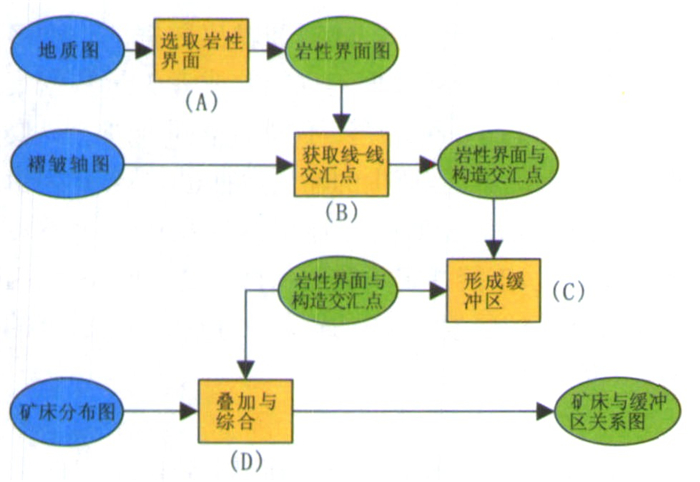
 下载:
下载:
